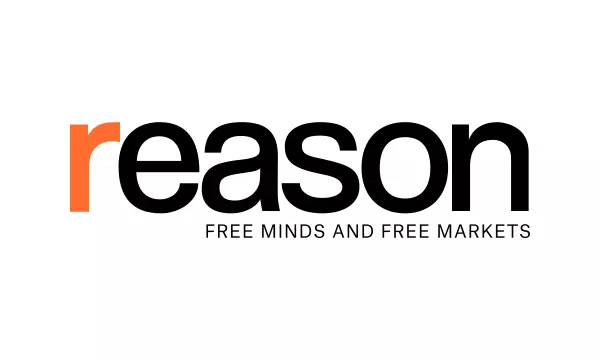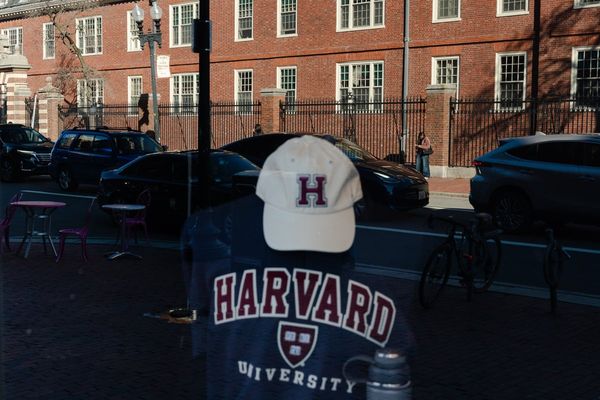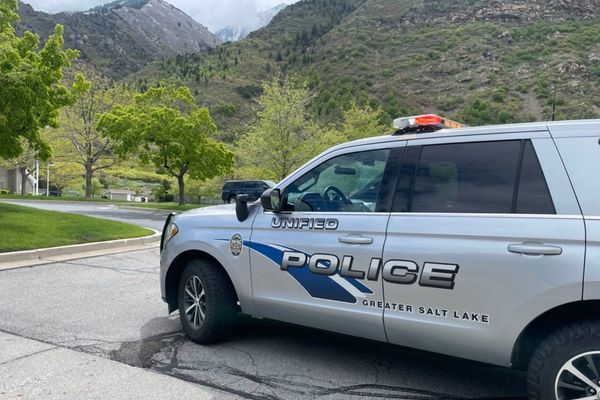
There is a scene in the Netflix super hit Adolescence, about an elfin-faced 13-year-old boy who stabs to death a female schoolmate, motivated by a fear and loathing of women apparently fuelled by his exposures online, that is not – relatively speaking– very tense.
The lead investigator, DI Luke Bascombe, played by Ashley Walters, is roaming the children’s bleak, grey high school searching for clues as to the murder weapon and the motive. His own son, Adam (Amari Bacchus), a gangly, bullied senior, takes his father aside into a room of stacked chairs and blue-tinged light. He wants to help him understand.
“It’s not going well, because you’re not getting it,” he says. The adults have fundamentally missed or misinterpreted what the children are doing online, he says. Dynamite emojis, the manosphere, orange-coloured heart emojis. “It’s all got a meaning,” he says.
The detective is baffled at first (is he talking about the Matrix? Is it bullying?) but tries to understand his son. “This is useful,” he says. “I didn’t know.”
***
Since its launch just a fortnight ago, the Netflix series has attracted a global audience of more than 66 million viewers (about the population of France), been fêted by critics and pegged as an award season winner. It has also prompted a deluge of commentary, conversation and concern about the impact online cultures and social media has on very young people. The portrait of adolescent boys as angry, under-socialised and vulnerable to deeply misogynistic messages and influencers has unnerved and horrified Adolescence’s audience.
It has been called “a wake-up call for all of us”. But have the alarm bells turned alarmist? When does a wake-up call become a moral panic, and how concerned should we be?
“There is a sense that, yes, there’s some kind of moral panic – which I think is appropriate,” says Samantha Schulz, associate professor of sociology of education at the University of Adelaide. “For the most part it seems to me that people are yet to understand, actually, the magnitude and the significance of what we’re looking at.”
Dr Stephanie Wescott, like Schulz, has been researching misogyny in schools for some time. Talking about gender-based violence and misogynist radicalisation, she says, has led to her and research partner Steven Roberts being pegged as alarmist in the past. With the advent of Adolescence, she says, “I feel now the conversation has caught up to the scope of the problem. I feel we do need to be a little bit alarmist here, because what is happening is alarming.”
Research released by Wescott last year, based on qualitative interviews with 30 female teachers, found that sexism – long identified in research on schools – endures still, “resurrected in part by the ubiquity and influence of one specific misogynist ‘manfluencer’, Andrew Tate”. An anonymous online survey of more than 130 South Australian teachers conducted by Schulz last year found teachers identifying a “heightened use of misogynistic language and behaviours by male students, some as young as five”.
If anything, says Wescott, by Adolescence focusing on this extreme expression of misogyny – the stabbing murder of one child by another – “we may miss a conversation about what is happening every day and the very routine and sometimes even mundane ways that these expressions of misogyny and sexism are coming from young boys in schools”.
The mundane is not hard to find. At one inner-city primary school in an Australian capital, for example, after-school carers meet in advance of the students’ arrival to discuss the students of concern. Not least the boy who came in one day declaring “kill all women”, and the boys who will respond only to male carers. It’s all they talk about, one carer says – how the boys seem “like they’re mad about something that hasn’t even happened yet”.
At another school in a well-heeled Sydney suburb, boys in year six circulate an online ranking of the hotness of their female classmates. The class parents’ WhatsApp chat is peppered by parents insisting it is not their boys, and parents of girls sharing their daughters’ distress.
Then there are other everyday expressions of misogyny that spill out of the group chats and into the broader conversation, including deepfake porn of girls, made by their male classmates, and elite school boys chorusing misogynistic chants on public transport.
Wescott says these more quotidian offences are red flags that may foreshadow more serious behaviours in the future. She has spoken to female teachers who have identified misogynistic behaviour in boys and then seen some of those individuals go on to become violent offenders. “The women feel like there was missed opportunities around their time at school and that the red flags were not recognised.”
‘It is bigger than we think’
Prof Michael Salter, director of Childlight East Asia and the Pacific hub at the University of New South Wales, tends to avoid the term “moral panic”, but does thinks we may be having one. When we look at who constitutes the misogynist hardcore in society, he says, it is not young men; it’s older men.
“The idea that young men today are more misogynistic than they were 20 or 30 years ago, I don’t see any evidence for this.”
Salter recalls his own primary and high school years, where sexual harassment was rife and normalised. The average age of sexual harassment of girls is prepubescent, he says, and “that’s been the case for decades”.
“I’m not suggesting there’s nothing new about what we’re seeing or experiencing, but I think there is a pronounced tendency to explain the types of violence that we’re seeing from adolescent boys at the moment according to social media, and frankly I think we’re potentially missing the forest for the trees here.
“We’ve got some really complex challenges on our hands with boys, and I think social media and Andrew Tate have become quite a convenient way to answer that question without really challenging some of our underlying assumptions that really need challenging … I think we could cut off social media tomorrow and still have really high rates of violence committed against girls and women by teenage boys because frankly they’ve always been the group most at risk of committing gender-based violence, well before the internet.”
The problem of understanding whether this everyday misogyny is on the rise or stable in young boys and adolescents in schools is in part the result of a fundamental omission: we do not record it.
“We need a reporting instrument so that we get a sense of the magnitude of the issue, because it is bigger than we think,” says Schulz. “Because oftentimes particularly women teachers will learn not to say anything because the blowback from the institution can be just as bad.”
However, the first step is even more basic, says Wescott. “Before we could even measure or record [misogynistic behaviour or gender-based violence] we would need to use accurate language to describe what is going on,” she says. “Schools will often avoid using this kind of precise language, like reporting behaviour as misogyny or sexual harassment or sexual violence or gender-based violence. And in a way, I understand that these are very adult concepts.
“But calling it bullying, for example, which is one euphemism that is sometimes used, it misrepresents the gendered element,” she says. “We need to recognise the fact that this is happening in the first place, and be willing to mend it.”
‘The supposed pathology of boys’
In 1987 Australia became a world leader after it created national initiatives to promote gender equity in schools. “By the early 1990s, we actually had a fairly ground-breaking plan: it was called the National action plan for the education of girls,” says Schulz.
The plan fell out of favour in the conservative Liberal Howard government years and “gender justice” has remained largely absent from Australian schooling since, she says, leaving “a decades-long policy vacuum”.
Both Schulz and Wescott support “respectful relationships education”, which is at present only mandatory in Victorian schools.
“We know it is informed by the best evidence we have on what works in violence prevention,” says Wescott.
“It is intended to be a whole-of-school approach, and that means community, parents, leadership, school policies – every single aspect of the school is examined and reshaped and reformed to make schools safer, and to gear the schools towards violence prevention.”
But both she and Schulz say implementation has been piecemeal, ad hoc and generally lacking. “It’s good that we’ve got this, but it’ll be shoehorned into pastoral care, or areas of the curriculum that teachers and students alike will view it as the sidelines to the main event,” says Schulz. Teachers, not required to do any gender equity training at all as part of gaining their qualifications, can feel ill-equipped to deliver the work even when asked to.
For Schulz, part of the solution is to look to the successes of the early 90s. “We don’t have to reinvent the wheel. And these kinds of [gender] discourses and learning, just like learning English language or learning numeracy, [should be] part of what everyone learns,” she says.
“And then the messages that we are seeing just polluting young people’s minds through the manosphere, which is overwhelmingly large, would actually come up against some curiosity, some questioning, some resistance.”
Studies have suggested that such programs need also to address male vulnerabilities and victimhood. Schulz says responses must not be framed by “the supposed pathology of boys”.
The whole-of-school approach is the right way to go, says Salter, and must address the need “to acknowledge that misogyny flourishes in environments of abuse and trauma, where men and boys are afraid, where we’re scared to be vulnerable”. He doesn’t underplay endemic violence against women and girls, but wants to highlight the fact that boys are most at risk of male violence.
He says it’s not as though “we’re all really nice and friendly to each other and we just happen to be really awful towards girls and women.
“You know, that’s not the case.”
‘We’re the adults in the room’
In Adolescence, as the school at which the murdered girl and the boy who killed her returns to their daily routines, one teacher complains to another that now teachers must also be social workers. It is a complaint often returned by teachers to calls to do the work of respectful socialisation that many would lay at the feet of parents and the wider community. Both Schulz and Wescott are conscious of teacher workload and burnout and keen to not add to their workload.
However, Schulz says we need to recognise “schooling as a core cultural experience for virtually every young person”. As such, it has transformative power to shape not only individuals, but society in the future.
“Yes, the internet is powerful, it’s exponential, it’s unregulated,” she says. “But in terms of our social institutions that have any capacity to respond en masse, we have to look at schooling.”
Salter says schooling is part of the solution, but to effectively combat male violence and misogyny we need to address the risk factors that make men vulnerable to this world and behaviours – those most at risk have the highest rates of adverse childhood experiences, highest rates of suicidality, lowest rates of physical and mental health. “It’s not just some spiritual sickness that’s floating around in the ether,” he says.
Whatever the approach, he says, adults need to take ownership of the problem. “Fundamentally, we need to approach children as children,” says Salter. “We need to take responsibility as adults for the social context in which we force our children to grow up in.
“If there’s a problem with their behaviour, it’s because of us – because we’re the adults in the room, they’re children. They don’t take responsibility for massive social problems like violence against women.”
Weeping in their bedroom at the end of the last episode of Adolescence, the parents of Jamie Miller, the boy murderer, parse what went wrong. His father, a good father, turns to the good mother and asks: “Should we have done more, though?”
• This article was amended on 29 March 2025 to correct a misspelling of the researcher Steven Roberts’ name.







